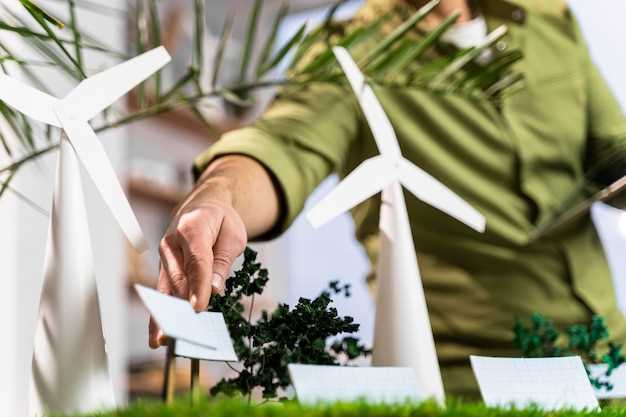
In a world where progress and development are at the forefront of our minds, it is crucial to explore alternative approaches that can lead us towards a brighter and more environmentally conscious future. As we strive to find innovative solutions to the challenges we face, it becomes increasingly evident that the integration of eco-friendly technologies is paramount in achieving sustainable growth.
Embracing a mindset that prioritizes the preservation of our planet, green technology solutions emerge as the driving force behind this transformative journey. By harnessing the power of nature and combining it with cutting-edge advancements, we can pave the way for a harmonious coexistence between human progress and the natural world.
With a focus on creating a better tomorrow, these sustainable initiatives encompass a wide range of fields, from energy production and transportation to waste management and urban planning. By adopting these forward-thinking approaches, we can mitigate the negative impact of human activities on the environment, while simultaneously fostering economic growth and social well-being.
Through the integration of renewable energy sources, such as solar and wind power, we can reduce our dependence on fossil fuels and significantly decrease carbon emissions. This transition not only ensures a cleaner and healthier environment but also opens up new avenues for job creation and economic prosperity. Additionally, the implementation of smart grids and energy-efficient systems allows for optimized energy consumption, minimizing waste and maximizing efficiency.
Furthermore, green technology solutions extend beyond energy production, encompassing sustainable transportation alternatives that revolutionize the way we move. From electric vehicles to public transportation systems powered by renewable energy, these innovations not only reduce air pollution but also alleviate traffic congestion, improving the quality of life in urban areas.
As we navigate the challenges of the 21st century, it is imperative that we embrace the potential of green technology solutions. By investing in sustainable innovations, we can forge a path towards a better future, where economic prosperity and environmental preservation go hand in hand. Together, let us embark on this transformative journey and create a world that thrives on the principles of sustainability and innovation.
Harnessing Renewable Energy Sources for a Greener Tomorrow
In the pursuit of a more sustainable and environmentally-friendly future, the utilization of renewable energy sources plays a crucial role. By tapping into the power of nature’s abundant resources, we can pave the way for a greener tomorrow without compromising the needs of future generations.
Unlocking the Potential of Renewable Energy
Renewable energy sources, such as solar, wind, hydro, and geothermal power, offer a viable alternative to traditional fossil fuels. These sources are naturally replenished and have a significantly lower impact on the environment. By harnessing the power of the sun, wind, water, and heat from the Earth’s core, we can generate clean and sustainable energy to meet our growing energy demands.
Advantages of Renewable Energy Sources
The adoption of renewable energy sources brings numerous benefits to both the environment and society. Firstly, it reduces greenhouse gas emissions, helping to combat climate change and mitigate its adverse effects. Additionally, renewable energy sources promote energy independence, as they can be harnessed locally, reducing reliance on imported fossil fuels. Moreover, the development of renewable energy technologies creates job opportunities and stimulates economic growth.
Furthermore, renewable energy sources are inherently resilient and decentralized. Unlike traditional energy systems that rely on centralized power plants, renewable energy can be generated on-site, closer to the point of consumption. This decentralization enhances energy security and reduces the vulnerability of the grid to disruptions.
As we strive for a greener tomorrow, it is imperative to embrace and invest in renewable energy sources. By doing so, we can pave the way for a sustainable future, reduce our carbon footprint, and ensure a better quality of life for future generations.
The Role of Eco-Friendly Innovations in Combating Climate Change
As our planet grapples with the pressing issue of climate change, it has become imperative to explore sustainable alternatives that can mitigate its adverse effects. In this regard, eco-friendly innovations have emerged as a crucial player in the fight against climate change. These innovative solutions, characterized by their environmentally conscious nature, offer a glimmer of hope for a more sustainable future.
Addressing the Environmental Crisis
Eco-friendly innovations play a pivotal role in addressing the environmental crisis caused by climate change. By reducing carbon emissions, conserving natural resources, and promoting renewable energy sources, these innovations help to mitigate the negative impact of human activities on the planet. They offer sustainable alternatives to traditional practices, enabling us to transition towards a greener and more sustainable future.
Promoting Resilience and Adaptation
Another significant role of eco-friendly innovations lies in promoting resilience and adaptation to the changing climate. These innovations empower communities and industries to adapt to the challenges posed by climate change, such as extreme weather events and rising sea levels. By implementing sustainable practices and technologies, we can enhance our ability to withstand and recover from the impacts of climate change, ensuring a more secure and sustainable future for generations to come.
In conclusion, eco-friendly innovations have a vital role to play in mitigating climate change. By addressing the environmental crisis and promoting resilience and adaptation, these innovations offer a pathway towards a more sustainable future. It is imperative that we continue to invest in and embrace these technologies, as they hold the key to safeguarding our planet and creating a better world for future generations.
Sustainable Transportation: Revolutionizing the Way We Travel
Transportation plays a crucial role in our daily lives, enabling us to move from one place to another. However, traditional modes of transportation have had a significant impact on the environment, contributing to pollution and climate change. In recent years, there has been a growing focus on sustainable transportation solutions that aim to revolutionize the way we travel, minimizing our ecological footprint and creating a greener future.
One of the key aspects of sustainable transportation is the promotion of alternative fuel sources. By shifting away from fossil fuels and embracing renewable energy options such as electric power, hydrogen fuel cells, and biofuels, we can significantly reduce greenhouse gas emissions and air pollution. These innovative technologies not only offer cleaner and greener transportation options but also contribute to energy independence and security.
Another important aspect of sustainable transportation is the development of efficient and eco-friendly modes of travel. This includes the advancement of public transportation systems, such as buses, trains, and trams, which can accommodate a larger number of passengers and reduce the number of individual vehicles on the road. Additionally, the promotion of cycling and walking as viable modes of transportation not only improves physical health but also reduces traffic congestion and carbon emissions.
Furthermore, the integration of smart transportation systems and technologies is revolutionizing the way we travel. Intelligent transportation systems, such as traffic management systems, real-time information services, and smart parking solutions, optimize the use of existing infrastructure and improve overall efficiency. Additionally, the emergence of ride-sharing and carpooling platforms has transformed the way we commute, reducing the number of vehicles on the road and promoting resource sharing.
In conclusion, sustainable transportation solutions are reshaping the way we travel, offering greener and more efficient alternatives to traditional modes of transportation. By embracing alternative fuel sources, developing eco-friendly modes of travel, and integrating smart transportation systems, we can create a more sustainable future, reducing our impact on the environment and improving the quality of life for future generations.
Green Buildings: Designing a Sustainable Future
Creating a sustainable future through the design and construction of environmentally-friendly buildings is a crucial step towards a greener and more efficient world. By incorporating innovative and eco-friendly practices, green buildings aim to minimize their impact on the environment while maximizing energy efficiency and occupant comfort.
1. Energy Efficiency

One of the key aspects of green building design is energy efficiency. By utilizing advanced insulation materials, efficient heating and cooling systems, and smart technologies, green buildings can significantly reduce energy consumption. This not only helps to lower greenhouse gas emissions but also leads to substantial cost savings for building owners and occupants.
2. Sustainable Materials
Green buildings prioritize the use of sustainable materials throughout the construction process. This includes selecting materials that have a minimal environmental impact, such as recycled or renewable resources. Additionally, green buildings focus on reducing waste by implementing efficient construction practices and recycling materials whenever possible.
- Utilizing recycled steel and concrete for structural components
- Incorporating sustainably sourced wood for flooring and furniture
- Using low VOC (volatile organic compound) paints and finishes
3. Water Conservation
Water conservation is another important aspect of green building design. By implementing water-efficient fixtures, rainwater harvesting systems, and greywater recycling, green buildings can significantly reduce water consumption. This not only helps to preserve this valuable resource but also reduces the strain on local water supplies.
- Installing low-flow toilets, faucets, and showerheads
- Implementing rainwater harvesting systems for irrigation
- Using greywater recycling systems for non-potable water needs
Overall, green buildings play a vital role in shaping a sustainable future. Through their energy-efficient design, use of sustainable materials, and water conservation practices, they demonstrate that it is possible to create buildings that are not only environmentally friendly but also provide a comfortable and healthy living or working environment for occupants.
Waste Management Solutions: Turning Trash into Treasure
In the realm of environmental preservation and resource conservation, there exists a pressing need for effective waste management solutions. This section delves into the innovative approaches that aim to transform waste into valuable resources, thereby mitigating the negative impact of trash on our planet.
Unlocking the Potential of Waste
Waste, often perceived as a burden, possesses untapped potential that can be harnessed to create a more sustainable future. By adopting a circular economy mindset, waste management solutions strive to shift the paradigm from disposal to resource recovery. Through advanced technologies and strategic processes, various types of waste can be transformed into valuable commodities, reducing the strain on natural resources and minimizing environmental degradation.
The Power of Recycling and Upcycling

Recycling and upcycling play pivotal roles in waste management solutions, offering a means to divert waste from landfills and incinerators. Recycling involves the conversion of waste materials into new products, while upcycling focuses on repurposing discarded items into higher-value creations. By implementing efficient recycling and upcycling practices, we can significantly reduce the amount of waste generated, conserve energy, and decrease greenhouse gas emissions.
Furthermore, waste management solutions encompass not only the physical transformation of waste but also the implementation of effective waste reduction strategies. By promoting awareness and education, encouraging responsible consumption, and fostering a culture of waste reduction, we can collectively contribute to a more sustainable and prosperous future.
The Future of Agriculture: Sustainable Farming Practices for Food Security
In the realm of agriculture, the path towards a more sustainable and secure future lies in the adoption of innovative farming practices. These practices aim to ensure the long-term viability of food production while minimizing negative environmental impacts. By embracing sustainable farming methods, we can address the challenges of food security and pave the way for a brighter future.
One key aspect of sustainable farming is the promotion of organic and regenerative practices. These approaches prioritize the use of natural fertilizers, crop rotation, and biological pest control methods, reducing the reliance on synthetic chemicals and minimizing soil degradation. By nurturing the health of the soil, farmers can enhance crop resilience, improve nutrient content, and contribute to the long-term sustainability of agricultural systems.
Another crucial element of sustainable farming is the integration of precision agriculture techniques. This involves the use of advanced technologies such as remote sensing, GPS, and data analytics to optimize resource management. By precisely monitoring and managing inputs such as water, fertilizers, and pesticides, farmers can minimize waste, increase efficiency, and reduce the environmental footprint of their operations. Precision agriculture also enables better decision-making, allowing farmers to adapt to changing conditions and maximize yields.
Furthermore, the future of agriculture lies in the adoption of climate-smart practices. As climate change poses significant challenges to food production, it is essential to develop strategies that mitigate its impacts. This includes implementing resilient crop varieties, improving water management systems, and adopting climate-adaptive farming techniques. By embracing climate-smart practices, farmers can enhance their ability to withstand extreme weather events, reduce greenhouse gas emissions, and contribute to global efforts in combating climate change.
Lastly, the future of agriculture relies on fostering sustainable food systems that prioritize local production and consumption. By promoting shorter supply chains and supporting small-scale farmers, we can reduce the environmental costs associated with long-distance transportation and support local economies. Additionally, encouraging diversified farming systems and promoting agroecology can enhance biodiversity, protect ecosystems, and contribute to the overall resilience of our food systems.
In conclusion, the future of agriculture lies in the adoption of sustainable farming practices that prioritize organic and regenerative approaches, integrate precision agriculture techniques, embrace climate-smart strategies, and foster sustainable food systems. By implementing these practices, we can ensure food security, protect the environment, and pave the way for a more sustainable and secure future.